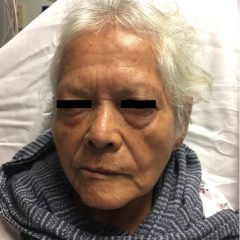Retinal Detachment
History of present illness:
A 58-year-old female presented to the emergency department reporting six days of progressive, atraumatic left eye vision loss. Her symptoms started with the appearance of dark spots and “spider webs,” and then progressed to darkening of vision in her left eye. She reports mild pain since yesterday. Her review of symptoms was otherwise negative. Ocular physical examination revealed normal external appearance, intact extraocular movements, and visual acuities of 20/25 OD and light/dark sensitivity OS. Fluorescein uptake was negative and slit lamp exam was unremarkable.
Significant findings:
Bedside ocular ultrasound revealed a serpentine, hyperechoic membrane that appeared tethered to the optic disc posteriorly with hyperechoic material underneath. These findings are consistent with retinal detachment (RD) and associated retinal hemorrhage.
Discussion:
The retina is a layer of organized neurons that line the posterior portion of the posterior chamber of the eye. RD occurs when this layer separates from the underlying epithelium, resulting in ischemia and progressive photoreceptor degeneration, with potentially rapid and permanent vision loss if left untreated.1 Risk factors include advanced age, male sex (60%), race (Asians and Jews), and myopia and lattice degeneration.2 Bedside ultrasound (US) performed by emergency physicians provides a valuable tool that has been used by ophthalmologists for decades to evaluate intraocular disease.1,3
Findings on bedside ultrasound consistent with RD include a hyperechoic membrane floating in the posterior chamber. RD usuallyremain tethered to the optic disc posteriorly and do not cross midline, a feature distinguishing them from posterior vitreous detachments. Associated retinal hemorrhage, seen as hyperechoic material under the retinal flap, can often be seen.1,2 US can also distinguish between “mac-on” and “mac-off” detachments. If the retina is still attached to the macula (mac-on), central vision is preserved and emergent repair is essential before progression to a mac-off RD.2 In a prospective observational study, emergency physicians achieved 97% sensitivity, and 92% specificity in diagnosing this pathology on bedside US. Optic disc edema and vitreous hemorrhage accounted for the false positives.2 Emergent ophthalmology consultation was obtained for our patient who saw the patient the same day for vitrectomy.
Topics:
Retinal detachment, retinal hemorrhage, bedside ultrasound, POCUS.
References:
- Kilker B, Holst J, Hoffmann B. Bedside ocular ultrasound in the emergency department. Eur J Emerg Med. 2014;21(4):246-253. doi: 10.1097/MEJ.0000000000000070
- Brinton DA, Wilkinson CP. Retinal Detachment.Principles and Practice. Oxford GB: Oxford University Press; 2009.
- Shinar Z, Chan L, Orlinsky M. Ultrasound in emergency medicine: Use of Ocular Ultrasound for the Evaluation of Retinal Detachment. J Emerg Med. 2011;40(1):53-7. doi: 10.1016/j.jemermed.2009.06.001




